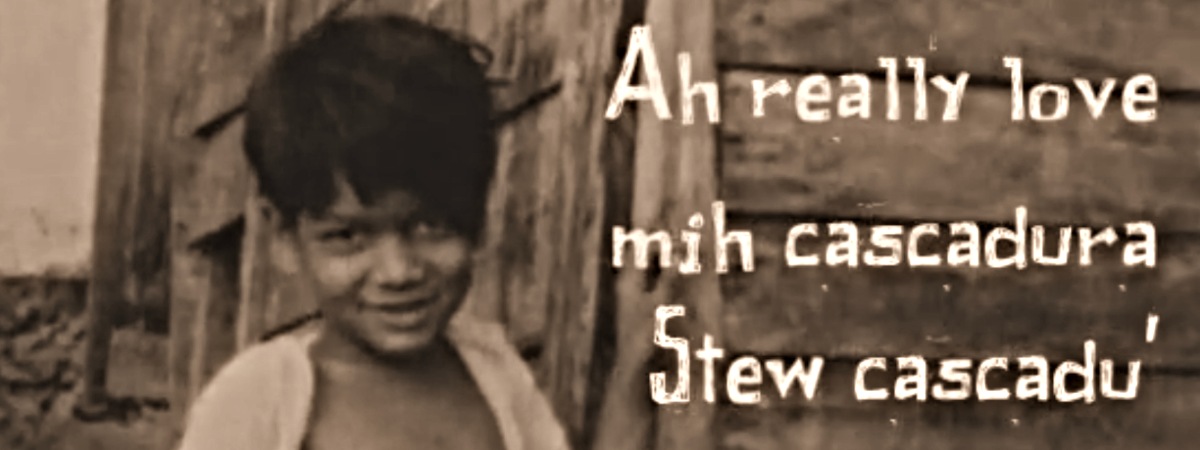|
The Zero Anthropology Project
Webfolio for Maximilian C. Forte 
HOME
|
SITE MAP
|
ABOUT
|
RESEARCH
|
MEDIA
|
ARTICLES
|
REVIEWS
|
COURSES
|
ZAP SITES
|
CONTACT



CASCADURA from Maximilian Forte on Vimeo.
Cascadura: Colonial, Local, Cosmopolitan
Roi Kwabena’s
spoken word poem, “Cascadura,” begins “simply”
enough, by representing a version of the locally
famous Trinidadian legend that attributes
magical power to the cascadura fish:
those who eat it are destined to return—and not
just return, but to end their days in Trinidad.
There is a poem of the legend, by Allister
Macmillan (Source: History of the West Indies
by Allister Macmillan, Nelson’s West Indian
Readers, Compiled by JC Cutteridge, Book III,
Lesson 9, Pg 42, 43; 1984 Nelson Caribbean), as
reproduced by Guanaguanare:
Those who eat the cascadura will, the native
legend says,
Wheresoever they may wander, end in Trinidad
their days.
And this lovely fragrant island, with its
forest hills sublime,
Well might be the smiling Eden pictured in
the Book divine.
Cocoa woods with scarlet glory of the
stately Immortelles,
Waterfalls and fertile valleys, precipices,
fairy dells,
Rills and rivers, green savannahs, fruits
and flowers and odours rich,
Waving sugar cane plantations and the
wondrous lake of pitch.
Oh! the Bocas at the daybreak—how can one
describe that scene!
Or the little emerald islands with the
sapphire sea between!
Matchless country of Iere, fairer none could
ever wish.
Can you wonder at the legend of the
cascadura fish?
In some ways, the late anthropologist and
cultural activist
Dr. Roi Kwabena uses the same basic
theme: enchantment, love, return, and a
catalogue of the everyday beauties in which
Trinidadians revel. This piece brings into focus
the shared, everyday love of all the things that
make daily life in Trinidad, the unquenchable
desire to return, to revel in the sights,
sounds, smells, tastes, and touch of Trinidad.
Yet his spoken word poem becomes even more
complicated. This combination of the colonial,
the traveler, the visitor, the local, the
migrant, all combine I think to produce a
locally rooted, locally shaped cosmopolitanism,
not universal but accessible to all with some
depth of experience in Trinidad.
Guanaguanare, mutual friend of Roi and myself,
has taken the time to produce the
full transcript of Roi’s poem.
First,
who is the speaker? Is there only one voice?
The poem by Roi Kwabena is first spoken by
someone with the accent and the polite and
affected elite tone of the colonial foreigner.
This person has a cook, Singh. The speaker says
that she would not ban neither Hosay nor
Ramleela, which suggests she has this power, and
that she has a somewhat patronizing appreciation
of local cultural performances. The original
legend itself seems directed at those who would
come and go from Trinidad, but could arguably
extend to natives themselves who migrate. But
clearly there is another speaker in this poem,
even referring to himself directly, “Me,
throwing mangoes….”. He lists all of the simple,
rich wonders of life in Trinidad, seemingly
common and everyday types of things—these are
shared reference points for all Trinidadians,
and probably all Trinidadians abroad could and
do reproduce such lists when thinking back
nostalgically about home, what they miss most,
what they remember, and what they would like to
do when they return. (True to his word, Roi did
end his days in Trinidad: his ashes were
scattered at Mayaro.) This raises another
dimension of the poem, as follows.
Second,
what is the tense? The poem seems to lack
a tense, which seems deliberate. On the one
hand, memory is implied, in returning. There is
a future: when one ends one days. But there is
also lived everyday experience: the list of
Trinidad’s wonders, which can also be stated
from memory, or because one is actually
experiencing them in the present. These
ambiguities in mind, I chose to portray a
certain chronology in the poem: past experience,
memory, return, reintegration.
The Visual Method
Animating a spoken word poem is always
difficult, especially if the aim is to bring out
even more ethnographic depth, simply because the
visual always adds another narrative beyond the
spoken (which also contains within it evocations
of the visual and brings into play all of the
other senses by imaginary means). The problem
can be that the visual
animator—myself—inadvertently adds other
meanings, conjures up different associations,
and inserts a narrative other than what the
original author chose (this brings up
collaboration, next).
Given some of the considerations above, this is
an explanation of the choices made. The “white
woman” who appears in the video is the
representation of the elite, colonial foreigner
who falls in love with Trinidad and vows to end
her days there. Local steel pan players and
other musicians can be taken as representations
of Roi. The local children at one point,
smiling, pointing at the camera, are there as if
to call Roi back home. Hence the view from an
airplane wing, moving from memory of the past
(depicted via grainy, sometimes sepia-coloured
archival footage), to the present–and thus a
shift occurs in space and time, depicted by a
shift from black and white to colour. Once
returned, full colour and contemporary scenes
are shown via personal video footage taken
during Carnival 1998.
Collaboration?
This joint production was not a collaborative
effort, in the sense that the animation and
visualization occurred well after Roi’s death
and without the benefit of his advice and
guidance. That means that to the extent the
piece is enjoyed and appreciated, the credit
goes to Roi, and where its failings appear, then
only I can take the blame.
Cascadura was the very first spoken word
poem recording that Roi sent to me back in 2006.
I have had many years to listen to it countless
times, and early on Roi and I exchanged some
correspondence about this work. I knew Roi at
first as a publisher, writer, and activist, so
this opened up a whole new dimension to my
appreciation of the breadth of his commitment
and creativity. As someone who has spent many
years in Trinidad, living, studying, and doing
research in the country, I am hoping that I was
able to interpret Roi’s spirit as best as
possible, while working with inevitable
limitations in terms of the footage available to
me.
HOME
|
SITE MAP
|
ABOUT
|
RESEARCH
|
MEDIA
|
ARTICLES
|
REVIEWS
|
COURSES
|
ZAP SITES
|
CONTACT

©
2011-2020, Maximilian C. Forte.
|